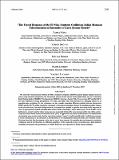Por favor, use este identificador para citar o enlazar a este item:
http://hdl.handle.net/10261/218566COMPARTIR / EXPORTAR:
 SHARE SHARE
 CORE
BASE CORE
BASE
|
|
| Visualizar otros formatos: MARC | Dublin Core | RDF | ORE | MODS | METS | DIDL | DATACITE | |

| Título: | The Forced Response of the El Niño–Southern Oscillation–Indian Monsoon Teleconnection in Ensembles of Earth System Models |
Autor: | Bódai, Tamás; Drótos, Gábor CSIC; Herein, Matyas; Lunkeit, Frank; Lucarini, Valerio | Palabras clave: | ENSO | Fecha de publicación: | 15-feb-2020 | Editor: | American Meteorological Society | Citación: | Journal of Climate 33(6): 2163-2182 (2020) | Resumen: | We study the teleconnection between El Niño–Southern Oscillation (ENSO) and the Indian summer monsoon (IM) in large ensemble simulations, the Max Planck Institute Earth System Model (MPI-ESM), and the Community Earth System Model (CESM1). We characterize ENSO by the June–August Niño-3 box-average SST and the IM by the June–September average precipitation over India, and define their teleconnection in a changing climate as an ensemble-wise correlation. To test robustness, we also consider somewhat different variables that can characterize ENSO and the IM. We utilize ensembles converged to the system’s snapshot attractor for analyzing possible changes in the teleconnection. Our main finding is that the teleconnection strength is typically increasing on the long term in view of appropriately revised ensemble-wise indices. Indices involving a more western part of the Pacific reveal, furthermore, a short-term but rather strong increase in strength followed by some decrease at the turn of the century. Using the station-based Southern Oscillation index (SOI) as opposed to area-based indices leads to the identification of somewhat more erratic trends, but the turn-of-the-century “bump” is well detectable with it. All this is in contrast, if not in contradiction, to the discussion in the literature of a weakening teleconnection in the late twentieth century. We show here that this discrepancy can be due to any of three reasons: 1) ensemble-wise and temporal correlation coefficients used in the literature are different quantities; 2) the temporal moving correlation has a high statistical variability but possibly also persistence; or 3) MPI-ESM does not represent the Earth system faithfully. | Versión del editor: | https://doi.org/10.1175/JCLI-D-19-0341.1 | URI: | http://hdl.handle.net/10261/218566 | DOI: | 10.1175/JCLI-D-19-0341.1 | ISSN: | 0894-8755 | E-ISSN: | 1520-0442 |
| Aparece en las colecciones: | (IFISC) Artículos |
Ficheros en este ítem:
| Fichero | Descripción | Tamaño | Formato | |
|---|---|---|---|---|
| earth_system_models.pdf | 6 MB | Adobe PDF |  Visualizar/Abrir |
CORE Recommender
SCOPUSTM
Citations
25
checked on 12-abr-2024
WEB OF SCIENCETM
Citations
22
checked on 22-feb-2024
Page view(s)
98
checked on 19-abr-2024
Download(s)
110
checked on 19-abr-2024
Google ScholarTM
Check
Altmetric
Altmetric
NOTA: Los ítems de Digital.CSIC están protegidos por copyright, con todos los derechos reservados, a menos que se indique lo contrario.
